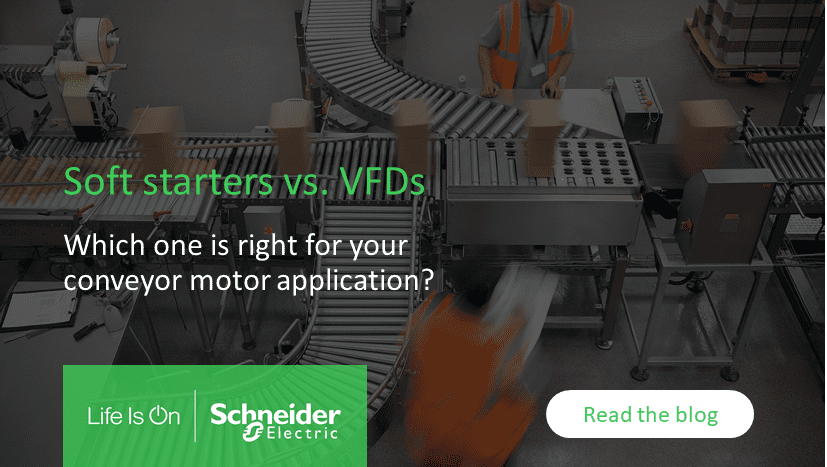Whether you’re specifying a new conveying system or looking to upgrade your existing material handling operation, modern AC drives offer solutions to help you:
- Capitalize on your space
- Adapt to application needs
- Keep communications open
- Enhance safety and security
- Maximize performance
- Simplify systems
- Maintain productivity
Advanced AC drive technology for conveyors has taken a big step forward, offering opportunities to address these challenges, while reaping key benefits such as improved productivity, performance, connectivity, and security.
Read on to learn how modern AC drives can help overcome these common problems.
Capitalizing on your space
Modern drives are designed to fit in all sorts of spaces.
If you need to centralize your AC drives in one or two high-density, single control panels, modern AC drives come in a book format, 45 and 60 mm (1.77 and 2.63 in.) wide. The book format is designed to be mounted side-by-side to save significant space on the installation footprint.
If you have distributed drives in small control panels, the compact format — 72 to 180 mm (2.83 to 7.08 in.) wide — can fit panel depths up to 200 mm (7.90 in.). The compact format mounts directly on the conveyor or integrates into existing machines. These two form factors fit practically any application or machine layout.

Adapting to application needs
Don’t get locked into a single operating mode for your AC drive. Instead, choose one that handles both open- and closed-loop control. An open-loop control system acts entirely on the basis of input, and the output does not affect the control action. With closed-loop control, the drive uses the encoder feedback in its control algorithm. That allows it to understand what output to give the motor to run at the desired speed and torque.
What’s more, modern drives can also pair with three-phase synchronous motors, as well as asynchronous motors and reluctance motors. The latter motors have shown to improve efficiency and save energy.
Keeping communications open
Staying current with today’s increasingly connected industrial environments requires equipment that can integrate with various network topologies. Modern AC drives have a variety of embedded standard protocols to accommodate conveying applications such as Ethernet protocols like Modbus TCP, Ethernet/IP, ProfiNet, EtherCAT, and Powerlink to increase their productivity and efficiency. And legacy protocols such as CANopen, PROFIBUS DB, and DeviceNet. Expect modern AC drives to integrate easily with any automation architecture.
Enhancing safety and security
Modern AC drives are designed with worker safety in mind. To comply with global machine safety standards (i.e., EN ISO 13849-1), you can find embedded safe torque off as standard and a full range of optional safety modules like safe stop category 1, safe stop category 2, safe operating stop, safe maximum speed, safe limited speed, guard door locking, safe direction, and safe brake control.
Modern drives contain lots of important system data, and connected systems need up-to-date cybersecurity. So, look for AC drives that offer certifications like Achilles level 2, which enhances the security of industrial automation controls through a comprehensive certification specification.

Getting the best performance
Dynamic conveying applications, like high speed sortation, require AC drives with rapid acceleration or settling time and optimized speed bandwidths of up to 400 hertz. Some state-of-the-art drives also offer one-millisecond application cycle time for more dynamic performance. The heavy-duty versions of these drives also have the capacity to high overloads of up to 220 percent of nominal torque without compromising performance or safety. The upfront additional cost is outweighed by performance improvements and better reliability.
Simplifying systems
Modern AC drives can streamline and simplify conveyor systems by reducing the number of components with built-in functions. For instance, you can minimize the need for programmable logic controllers by using on-board programmable logic functions that help integrate an AC drive into a specific application. You can also bypass other devices with options for rich interfaces, expanded I/Os, pulse train input/output control, and embedded encoders.
These drives also support simple application functions like parent-child and positioning mode, among others. An additional benefit is that they adapt and scale for a wide range of motor control.
Maintaining productivity
Advanced AC drives minimize set-up time and trade unplanned downtime for productive uptime. Choose a drive that integrates easily with a single plug-in connector for both power and control wires. Field device type/device type manager technology ensures interoperability, and one-button motor identification auto-tuning cuts commissioning time.
Once the system is online, the AC drive can communicate maintenance-oriented information via the web server and cloud connectivity to minimize unplanned downtime and reduce maintenance costs. Should something go wrong, state-of-the-art drives permit the automated transfer of device configurations, so your operation can be up-and-running again in less than 15 minutes. Faulty device replacement service allows fast machine recovery with quick device replacement and automated transfer of PLC configurations.
In the second blog in this series, we talk more about soft starters and VFDs, and provide insights on which one to choose for a conveyor motor application.
Looking for modern drives that can help meet the needs of your smart, high performing conveying systems? Schneider Electric Altivar Machine variable-speed drives deliver the seven benefits discussed in this blog.




